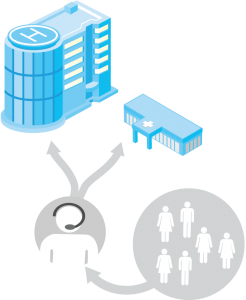One of the most effective ways of controlling costs, coordinating care, and ensuring consistent practices (leading to predictable and sustainable results) across a health system is through the implementation of a centralized Resource Management Center (RMC).
Also (although inaccurately) referred to as “centralized staffing,” centralized resource management is an approach that goes well beyond the framework of a call center taking ill calls and processing staff requests.
This strategy allows for in-depth schedule analysis and reporting functions while coordinating and carrying out a system’s workforce management, deployment, and alignment strategies, providing:
Improved coordination of resources
Proactive identification of needs/gaps
Reduced labor costs
Economies of scale
Better communication
Standardized processes
Additionally, centralized resource management frees nurse managers/directors from many of the tasks and administrative duties that keep them from mentoring staff and providing care to patients.
What size hospitals/systems can benefit from this strategy?
A full-service RMC can be highly effective for nearly any size facility. Larger organizations and multiple-hospital systems will be able to reap substantial gains relative to economies of scale and the bottom line savings of optimizing labor can amount to tens of millions of dollars, but smaller facilities (around 200 beds) can experience tremendous gains as well.
__________________________________________________________________
Learn how SSM Health Care – St. Louis saved more than $23M in contingency
staffing costs due in part to their adoption of a Resource Management Center.
__________________________________________________________________
Obviously, the resources (FTEs) appointed to the RMC at a smaller facility will vary and the responsibilities may involve things outside those typically performed by a resource management specialist/analyst, but the benefits of a coordinated and sophisticated approach to managing labor are perhaps more important at smaller facilities which have much less room for inefficiencies.
An RMC can also provide support, schedule analysis services, and handle administrative responsibilities for areas outside of inpatient nursing, including Radiology, ED, Pharmacy, etc.
The RMC strategy is also beginning to be utilized within multiple-site practice groups, or clinic operations. As medical group practice consolidation is on the rise and outpatient clinics are fast becoming the growth and profit centers of larger systems, it is logical that increasing attention is being paid to effective labor management practices, including floating staff between clinics and the implementation of clinic-specific float pools – two strategies that meld perfectly with the RMC concept.
Myths of the Centralized Resource Management strategy
One of the arguments often cited against centralizing resource management is based on the idea that units will lose control of the decision-making process relative to staffing. Some unit managers and directors fear the RMC is too detached from what is happening on the unit – that they won’t understand the needs of the unit and the thousand other intricacies directors and mangers intuitively know through their years of experience.
It is this degree of separation, however, and the ability to view resources at the enterprise level that allow for a more objective and strategic approach to placing resources that will benefit the entire system. RMC staff do not make clinical decisions. Those decisions are made by a clinical decision maker (typically a house supervisor). The clinical decision maker works with the RMC and unit managers and directors to gain an understanding of the entire staffing picture and makes decisions based on a complete understanding of all the issues and all the resources in play.
Unit-based control of staff placement results in a “siloed” strategy. With a silo-approach, a director or manager concentrates on his or her own department or units without a complete picture of what is going on elsewhere within their organization. This often results with some units sending staff home while other, similar units, utilize overtime or bring in more expensive, last-minute sources of external staffing (agency), or run short.
With a 30,000-foot view of resources the RMC is able to clearly convey all available resources and possible movements to the assigned clinical decision maker(s), resulting in a standardized, cost-effective, and repeatable method of resource management and deployment.
The growing rate of system consolidation and the urgent need to control costs makes this strategy appropriate and timelier than ever before.
We have implemented this strategy in virtually every type of organization:
- Single-site hospitals
- Multi-hospital metropolitan systems
- Large, regional systems
- Systems with numerous critical access sites
- Academic medical centers
- Systems with extensive clinics operations
- Assisted Living / Long Term Care organizations
To learn more about how this strategy can work for your organization email me at jackie.larson@avantas.com.


